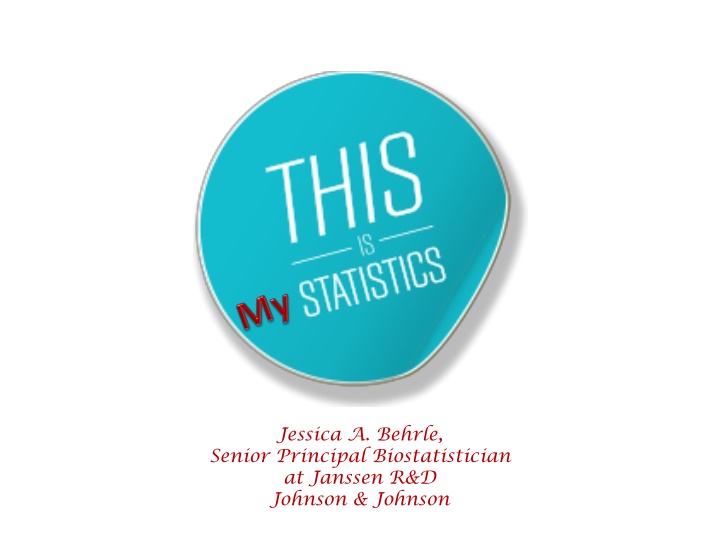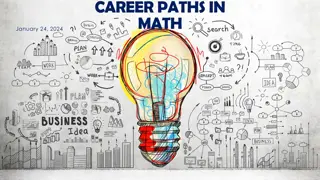Career Path and Duties of a Statistician at Janssen R&D
Jessica A. Behrle, a Senior Principal Biostatistician at Janssen R&D, shares insights into the world of statistics, highlighting the importance of studying statistics and essential skills for statisticians. Her career path, exposure to research experiences, nonclinical statistics support, and specialized work in analyzing data related to photoreceptor cells in rats' eyes are also discussed in detail. Gain a comprehensive understanding of the intriguing role of a statistician in various fields.
Download Presentation

Please find below an Image/Link to download the presentation.
The content on the website is provided AS IS for your information and personal use only. It may not be sold, licensed, or shared on other websites without obtaining consent from the author.If you encounter any issues during the download, it is possible that the publisher has removed the file from their server.
You are allowed to download the files provided on this website for personal or commercial use, subject to the condition that they are used lawfully. All files are the property of their respective owners.
The content on the website is provided AS IS for your information and personal use only. It may not be sold, licensed, or shared on other websites without obtaining consent from the author.
E N D
Presentation Transcript
Jessica A. Behrle, Senior Principal Biostatistician at Janssen R&D Johnson & Johnson
http://thisisstatistics.org/ Why Study Statistics
My career path to Stats LOVED MATH
Exposure to Stats Research Experience for Undergraduates Co-op
What Do I Do? Statisticians are doing detective work- numerical detective work - or counting detective work - or graphical detective work by John Tukey (famous statistician)
What are my Duties? Determine the questions or problems to be addressed and the data needed to answer them Determine methods for finding or collecting data Design ways to collect data Analyze and interpret data Report conclusions from their analyses
What Skills Are Important? Quantitative Computer Communication People Problem Solving
Nonclinical Statistics Support Preclinical/Discovery Manufacturing Consultant Teach Preclinical Clinical Post Lead Target Safety Phase I Phase II Phase III Marketing
Rats Eye Number of Photoreceptors (i.e., Thickness) was measured at locations across the retina. Retina 10 Special Acknowledgements to the creator: Ray Heslip , SIDD
Ex. # Photoreceptor Cells by Quadrant (i.e., Thickness) Temporal to Nasal T1 T4 T3 T2 N1 N2 N3 N4 S4 S3 12 10 10 11 11 11 10 11 S2 10 12 17 24 14 10 10 6 Superior To Inferior S1 11 10 10 11 10 10 17 13 I1 11 10 10 10 10 19 9 11 I2 12 12 13 13 15 22 11 10 I3 10 20 11 11 11 12 10 13 I4 11
Treatments Group Name Low dose Mid dose High dose WT Untreated Sham N Strain of Rat Dys Dys Dys WT Dys Dys Surgery Location Sub-retinal Sub-retinal Sub-retinal NA NA Sub-retinal 12 12 11* 12 12 11* Histology was obtained from 4 rats on day 30, 4 rats on day 60, and 4 rats on day 90. *Histology was obtained from only 3 rats on day 30. 12
Stat Methods of 1st Analysis Average thickness computed per quadrant and then modeled ( ) = + + + + + + + log Thickness Trt Day Quadrant + Rat Trt Day Trt Quadrant i j k Day l i j i k + Day Quadrant Trt Quadrant j k i j k ijkl where is Grand Mean Trti is Treatment Effect; i=high, mid, low, Sham, Untreated, and Wild Type (WT) Dayj is Day Effect; j=30, 60, and 90 Quadrantk is Quadrant Effect; k=TS, NS, TI, and NI Ratl is Random Effect for Rat; l=rat id# ijkl is residual error Pairwise comparisons of treatments =0.05 13
Results of 1st Analysis Overall High dose Untreated 78.2 12.5% Mid dose Untreated 73.9 11.9% Low dose Untreated 57.3 10.7% No overall significant difference is detected between the 3 doses. Largest diff High vs Low: 13.3 7.9% (p-value=0.081) Each dose has significant compared to WT. 15
Quadrant Results: Doses vs. Untreated Day 60 Day 90 TS NS TS NS TI NI TI NI smallest Arrows indicate statistically significant difference 16
Some of Statistical Analyses involved in Manufacturing Design - DOE Comparability Estimate Shelf-Life Set Specifications Preclinical Clinical Post Lead Target Safety Phase I Phase II Phase III Marketing Manufacture
Purification http://www.buildingbiologics.com/manufacturing-biologics.html
Difference between 2 sites Manufacturing a product in NA and EU Question to address: Is there a difference in the manufacturing process in these 2 regions? Collect the data from the 2 regions. 20 measurements from each region Measurement has values from 0 100 ( good) Combine, Understand and Show
ADVICE Consulting Courses Save your text books (you may need them later) Learn how statistics can be used in fields that interest you Internships/Co-ops
NOW IT IS TIME TO DEVELOP YOUR:























